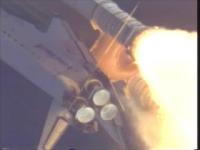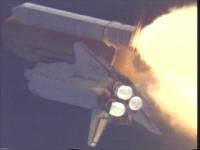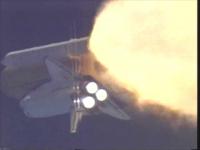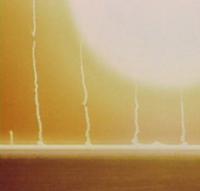Printable Version of Topic
Click here to view this topic in its original format
Unmanned Spaceflight.com _ Manned Spaceflight _ Curious Phenomena In Shuttle Launches
Posted by: ugordan Jan 25 2006, 09:34 PM
One thing has been bugging me for a while now. There's a curious feature that appears in many shuttle launch videos (well, not only shuttle videos, but they're most prominent there). I'm talking about the following optical effects:
Now, my sort-of-educated guess would be this is a shockwave related phenomenon. Once the launch vehicle becomes supersonic, it creates a shockwave that compresses air at its front. This changes the index of refraction if the shocking is strong enough.
The same thing happens during an atmospheric nuclear detonation where the shock can be seen "breaking" the traces of the smoke rockets behind the detonation (in case you ever wondered what the smoke rockets were for
I don't think it's related to optics in the tracker. Notice how the linear refraction is always perpendicular to the motion of the shuttle. What puzzles me is just how many of these linear features there are during the course of the liftoff. Furthermore, they seem to dance around each other exhibiting complex behavior one would not expect of a simple supersonic shock front...
Very interesting in any case, if anyone has more info about it, I'd be happy to hear it.
BTW, the launch video I took the screenshots from can be found at www.insideksc.com, specifically http://www.insideksc.cjb.net:8081/wwwroot_45/DIVX/sts-112/STS-112.LaunchReplay.PlayalindaDOAMS.avi.
Posted by: The Messenger Jan 25 2006, 10:07 PM
I'm guessing that you are half right: That these are indeed pressure waves, but not from the shuttle flight surfaces - from fluctuations in the pressure waves caused by burning of the solid rocket propellant. Solid fuel burns quite chaotically -it's a rough ride. In addition, since they burn the entire length of the motor, there is a characteristic (very deep) resonant frequency. One of the reasons aluminum is used in solid rocket fuel is that the fluffly burn product - aluminum oxide - dampens the resonance which could otherwise build a pressure wave that blows off the nozzle or bursts the case.
The nozzles are also flexed-vectored during the launch, and this changes the direction and amplitude of pressure waves. Since your viewing angle is 'down wind' from the nozzle exhaust, the combination of both the natural variation in the burnrate, nozzle vectoring, and exhaust gas radiant heating of the surrounding air can all change the reflective index. This combination of factors is a likely cause of the visual artifacts you observe.
Edited to add: Looking more closely, it looks like the main liquid fuel is adding to the 'fire' too, so the expansion and radiant heat of all the exhaust gases is the most likely culprit.
Posted by: ugordan Jan 25 2006, 10:23 PM
I have a problem with that reasoning since one would expect the "vibrations" to expand concentrically away from the engines, yet in the third picture it's clear it always seems to be a line, not a feature centered around the engines. In fact, that "line" part is most puzzling to me. The refractions don't seem to be curved at all. That IMHO implies the refracting is taking place much farther from the launch vehicle where the shockwave starts to look like a flat front.
It probably has to do with changing speed of sound and temperature gradients in the atmosphere as the vehicle rockets skyward.
I just can't believe the shockwaves are due to the rocket exhaust, that would imply vibrations so strong they would invariably rip through every launch vehicle in existence.
Posted by: dvandorn Jan 25 2006, 11:14 PM
I've seen that artifact many times -- it even appeared on the same tracking camera during the New Horizons Atlas V launch.
There was once a long discussion of it on sci.space.shuttle, and it was decided that it must be a real image artifact that occurs between the rocket and the camera, and not a camera artifact. I'm still not completely convinced, though.
-the other Doug
Posted by: tasp Jan 26 2006, 02:27 AM
The many protuberences of the shuttle (wings, OMS pods, rudder) all contribute to the multiple complex shock waves coming off the vehicle.
If I may be permitted (if this isn't too far off the topic), it seems about every launch I have watched closely, I will see a 'flare' or two in the shuttle main engine exhaust.
IIRC, they were even looked into during the Challenger accident investigation and were deemed 'acceptable' or some such thing.
But I have never seen anywhere, just what is it that causes them.
Tiny bits of turbine or bearings working there way through the plumbing? That sounds too scary to me to be correct.
It doesn't seem possible for there to be impurities in the fuel or oxidizer.
So does anyone know what makes the flares?
(incinerated pigeons caught in the exhaust? - that one is a joke)
Posted by: ugordan Jan 26 2006, 08:15 AM
I'm not sure what flares you have in mind, but I remember a recent study that announced that every shuttle launch brought a significant amount of water vapor over the south pole or something like that. I also clearly remember iron dust being mentioned as an additional exhaust product, apart from H2O.
Supposedly, the engine wears itself out ever so slowly, but enough to detect these trace amounts.
Is there a flare visible in the specific clip I linked above? If so, at what time?
While we're off-topic, there is a Proton launch (just about the only one I have in my collection) that also exhibited a flare at an early stage of liftoff. It gave out a red flash to an otherwise blue exhaust plume.
Also off-topic, notice how the bottom of the fuel tank insulation gradually gets charred. Is this due to infrared radiation from the engines or do some of the exhaust gases actually make it all the way up there and burn the foam?
The burn pattern looks pretty sharply defined so I'd bet on gas circulation. Which puzzles me - how can gas come back up when the whole vehicle is going supersonic and the air is dragging everything downwards? Must be one hell of a turbulence!
Posted by: helvick Jan 26 2006, 01:33 PM
Just to clarify what I think is being discussed:
http://www-pao.ksc.nasa.gov/kscpao/videos/metafiles/ksc_072605_rtf_launch.ram
You can see two separate effects - from the onboard camera there are a number of "flare" transients visible in the exhaust. These do not appear to be shock wave effects to me but rather appear to be caused by inconsistencies in the fuel flow. It is also definitely possible that they are caused to some degree by throttle control on the main engines affecting the SRB exhaust dynamic. Then again they might just be simple vibration effects - these are definitely not imaging artificacts.
Later on after the shuttle has passed through a cloud layer a very distinct Prandtl-Glauert condensation cloud appears suddenly around the top of the shuttle - it appears as a sort of shroud and persists for quite a while. This is a fairly typical atmospheric transonic\supersonic shock wave effect. I suppose it might be possible for such a cloud to form near the leading edge of the exhaust and then cause the flare effect as it dissipates as they can form and dissipate very rapidly.
Posted by: tty Jan 26 2006, 02:03 PM
The burn pattern looks pretty sharply defined so I'd bet on gas circulation. Which puzzles me - how can gas come back up when the whole vehicle is going supersonic and the air is dragging everything downwards? Must be one hell of a turbulence!
There is certain to be an area of flow separation and turbulent flow behind the fuel tank and with this very complex geometry and pressure distribution I wouldn't be in the least surprised by some "wrong-way" flow. Stranger things happen. There have even been cases where dropped bombs simply refuse to leave and fly along with the aircraft until the speed drops below a certain point!
tty
Posted by: paxdan Jan 26 2006, 02:52 PM
oh man that's priceless, i imagine that resulted in a few WTF moments.
Posted by: GregM Jan 26 2006, 05:27 PM
Wrong way flow? Were's a good example:
http://www.hq.nasa.gov/alsj/a11/ap11-KSC-69PC-413HR.jpg
Posted by: The Messenger Jan 26 2006, 05:28 PM
It probably has to do with changing speed of sound and temperature gradients in the atmosphere as the vehicle rockets skyward.
I just can't believe the shockwaves are due to the rocket exhaust, that would imply vibrations so strong they would invariably rip through every launch vehicle in existence.
They don't have to be shock waves - just enough variation in density to distort the image. Vectoring of the nozzle, and dynamic changes in the gas flow easily produce this type of effect. The linearity may be dictated by the displacement in the air stream caused by the leading shuttle surfaces. (Just a guess)
Turbulant flow definitely leads to heated backflow on the outside of the nozzles and the case. There was even one launch (non-shuttle) where a main engine shut down because the backflow overheated an internal sensor with an external vent - I don't recall exactly where or when.
It is not unusual for small - up to fist-sized chunks of propellent to break free from the main surface grain and burn down 'down stream' as glowing 'embers' in a solid rocket plume, and the nozzle pressure during a launch varies more than you would expect - I will try to find some real numbers.
Posted by: DDAVIS Jan 28 2006, 12:15 AM
[quote=The Messenger,Jan 26 2006, 05:28 PM]
They don't have to be shock waves - just enough variation in density to distort the image.
I believe, based on repeated occurences seen over the years, we are seeing video artifacts caused by radar or other local electronic interference. They look too straight to be caused by the ascent itself.
Don
Posted by: DDAVIS Jan 28 2006, 12:17 AM
message moved to new thread
Posted by: edstrick Jan 28 2006, 09:53 AM
I've seen the straight line "oddities" in shuttle launch video, and I've noticed that they seem to sweep past the shuttle, remaining straight lines. The arm-waving speculation I've had for these features is that they're due to the line-of-sight from the tracking camera to the shuttle is crossing some overhead wires some tens of meters from the camera. Tracking cameras are telescopes, not mere lenses, and the wires themselves may be nearly invisible, but in the sunlight, might be heated enough to have hot air "envelopes" that could cause weak linear mirages, which is what the oddities strike me as resembling.
Posted by: djellison Jan 28 2006, 10:18 AM
Personally, I think these are shock waves. Very similar features can be seen above Thrust SSC when it broke the sound barrier at Black Rock.
If you look carefully at some of the images of Thrust SSC - you can see some of the sort of thing - the slight 'double line' appears in the visualisation that appeared by kicking up dust
http://www.galleryoffluidmechanics.com/ss_cars/shockvsm.htm
And quite clearly here 
Somehow - the shockwave(s) have a large refractive index, as you can see in the Thrust SSC image. Now - the same process would refract light from the exhaust plume around to make it look like little bright lines which is what we see.
Doug
Posted by: ugordan Jan 28 2006, 11:14 AM
How would that explain that the lines are perpendicular to the shuttle motion and the fact they seem to dance around themselves as well?
Posted by: Bob Shaw Jan 28 2006, 02:23 PM
I'd say that the bright lines and spikes are created by internal reflections in the optical tracking system, and that they move around because the optical elements also move in order to track the Shuttle stack. The flaws in the image are only seen where there is very bright light, unlike in the Thrust SSC photo. You might well, for example, be seeing light reflected off cross-hairs in an off-axis aiming device.
Bob Shaw
Posted by: ugordan Jan 28 2006, 04:46 PM
Again, why would the lines be perpendicular to the shuttle motion vector?
The "flaws" are seen regardless of the brightness and they very much look like refraction patterns. I could buy the idea of optical artifacts if the lines behaved more orderly, however, they seem to follow the shuttle one moment and start to lag behind or overtake the orbiter the next (simultaneously with other lines appearing and NOT doing the same thing).
One thing's for sure: they appear to be located much closer to the camera as they aren't suffering from atmospheric turbulences as much as the actual orbiter is.
At what time after liftoff does the shuttle actually become supersonic? It would be a big benefit if there were another long range tracker footage that could show the same effect from a different angle.
Posted by: helvick Jan 28 2006, 07:00 PM
One thing's for sure: they appear to be located much closer to the camera as they aren't suffering from atmospheric turbulences as much as the actual orbiter is.
These are tracking cameras and they are not absolutely perfect in their targeting - the position of the orbitor within the frame will move as will the orientation of the camera relative to the orbiter so the effect as you describe it could be artifacts of the lens optics.
Posted by: ugordan Nov 6 2007, 08:43 PM
Sorry for resurrecting a long-dead thread, but I've just been watching the STS-115 chase plane footage (found on www.insideksc.com) and I saw what undeniably have to be shockwaves. Below's a screenshot from an enhanced clip, the clip's a bit noisy due to contrast enhancement, but refraction (shock "hooks") of the background clouds is readily apparent. This happened some time after Mach 1 transition and some condensation can still be seen sticking to the orbiter and SRB nosecone.
http://www.fileden.com/files/2007/9/14/1431389/STS-115_shockwave.mov
Click on the image for a short, slowed down Quicktime clip.
It would thus appear the groundtracker views showing the same effects are not artifacted.
How cool is this?
Posted by: helvick Nov 6 2007, 09:50 PM
Seems like pretty compelling evidence that what we saw before actually are sonic\transsonic\supersonic shock waves. I suppose these are a sort of standing wave supersonic shock front ?
Posted by: stevesliva Nov 6 2007, 10:36 PM
Made me think of "vapor cones"
http://en.wikipedia.org/wiki/Prandtl-Glauert_singularity
Posted by: ugordan Nov 6 2007, 10:49 PM
Nope, Prandtl-Glauert singularities have a very narrow Mach range when they can occur, something like Mach 0.95-1.05 so for a rapidly accelerating vehicle they're very shortlived. In most shuttle launches it can't even be seen if the air isn't humid enough. During this launch, the singularity came a while earlier: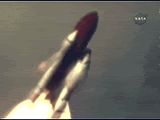
That's actually the point I referred to as the Mach 1 transition in the previous post.
A rare image showing the singularity as a faint disc:
Posted by: stevesliva Nov 6 2007, 11:07 PM
Neat! Conclusively something else.
Posted by: helvick Nov 6 2007, 11:28 PM
Seems to be an attached supersonic shock wave made visible because of the effect it has on the refractive index of the air rather than the condensation cloud that makes the Prandtl-Glauert singularity visible.
http://en.wikipedia.org/wiki/Shock_wave:
- These shocks appear as "attached" to the tip of a sharp body moving at supersonic speeds.
- Examples: Supersonic wedges and cones with small apex angles
- The attached shock wave is a classic structure in aerodynamics because, for a perfect gas and inviscid flow field, an analytic solution is available, such that the pressure ratio, temperature ratio, angle of the wedge and the downstream Mach number can all be calculated knowing the upstream Mach number and the shock angle. Smaller shock angles are associated with higher upstream Mach numbers, and the special case where the shock wave is at 90 degrees to the oncoming flow (Normal shock), is associated with a Mach number of one. These follow the "weak-shock" solutions of the analytic equations.
http://en.wikipedia.org/wiki/Shock_wave
Powered by Invision Power Board (http://www.invisionboard.com)
© Invision Power Services (http://www.invisionpower.com)
